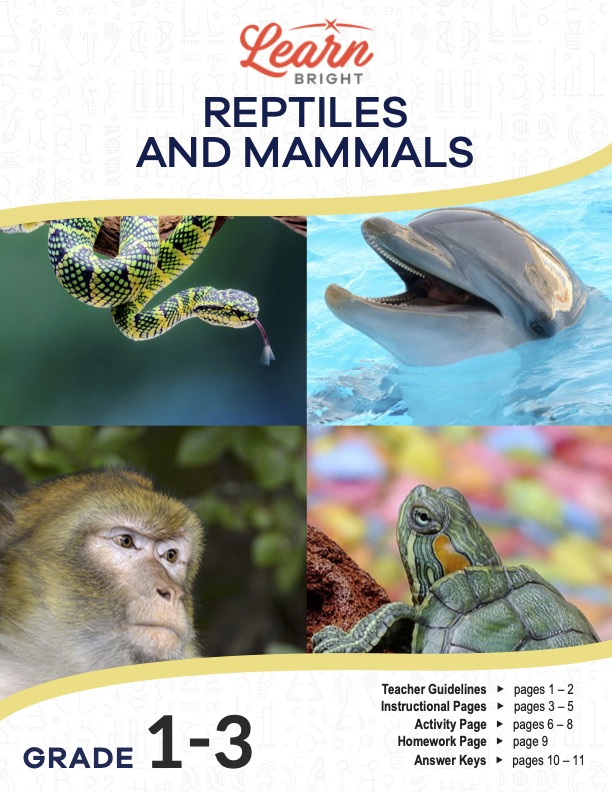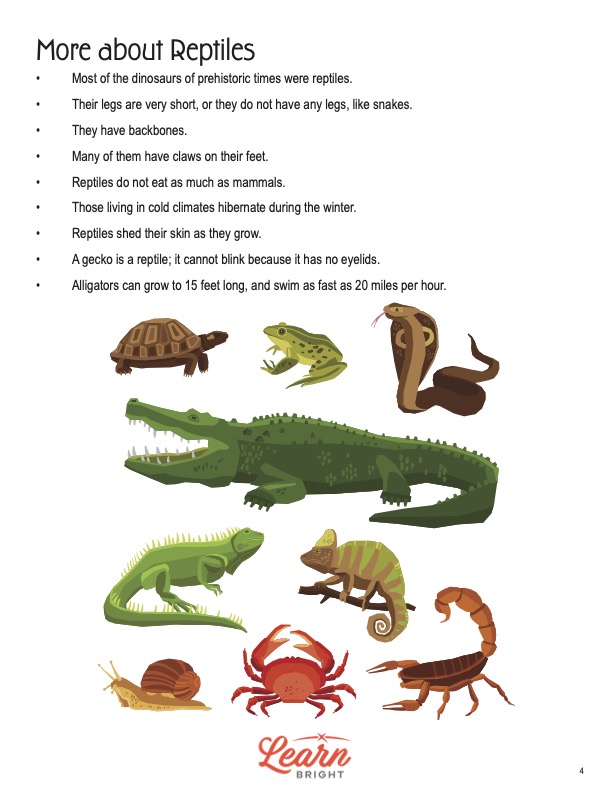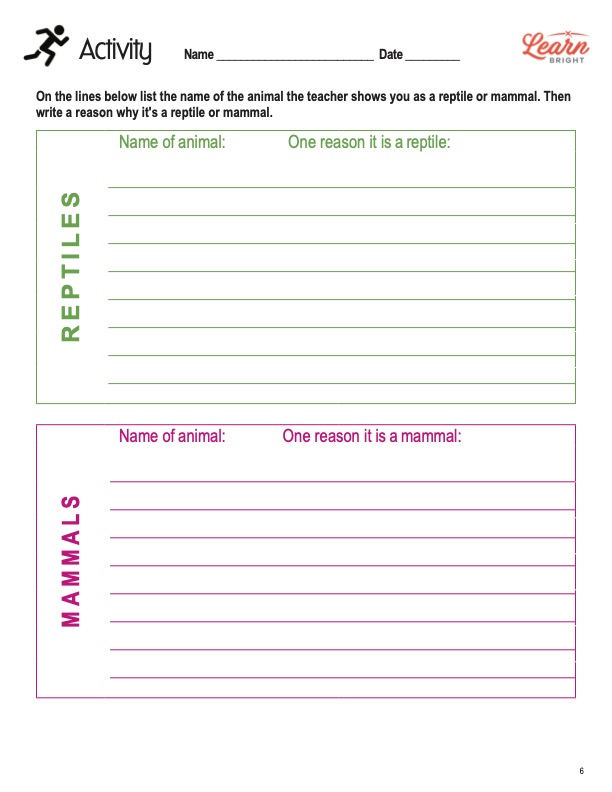Description
What our Reptiles and Mammals lesson plan includes
Lesson Objectives and Overview: Reptiles and Mammals teaches students about these two animal classes. Students will discover the various characteristics that help scientists classify animals into these categories. They will be able to compare and contrast the two groups and identify animals based on their common traits. The lesson is for students in 1st grade, 2nd grade, and 3rd grade.
Classroom Procedure
Every lesson plan provides you with a classroom procedure page that outlines a step-by-step guide to follow. You do not have to follow the guide exactly. The guide helps you organize the lesson and details when to hand out worksheets. It also lists information in the yellow box that you might find useful. You will find the lesson objectives, state standards, and number of class sessions the lesson should take to complete in this area. In addition, it describes the supplies you will need as well as what and how you need to prepare beforehand. In addition to the handouts, you will also need to supply scissors and either glue, tape, or paste for the lesson activity.
Options for Lesson
The “Options for Lesson” section of the classroom procedure page provides several ideas for additional activities or alternatives for the lesson. One option is to let students research reptiles and mammals on the internet so they can make their own list of facts for the activity. You could also assign a specific mammal or reptile for students to research and present as a written report, oral report, or other presentation. If you need to save time, another idea is to use the puzzle activity as a homework assignment instead. One final suggestion is to show videos involving these animals while students complete the activity.
Teacher Notes
The paragraph on the teacher notes page provides a little extra guidance as you prepare the lesson. It suggests using the internet to explore more information about these animal classes. You could use it, for instance, to show students animals that they may not find easily at a zoo or in everyday life. Use the blank lines on this page to write down any ideas or notes you have.
REPTILES AND MAMMALS LESSON PLAN CONTENT PAGES
Reptiles and Mammals
The Reptiles and Mammals lesson plan contains three pages of content. The first page mentions how there are many types of animals in the world, but that this lesson will focus on the two of the largest types: reptiles and mammals. These types of animals have many differences, but they also share a few common traits.
Students will learn that both groups of animals have been on earth for millions of years. Both classes breathe oxygen in order to survive, and both have backbones, which makes them vertebrate creatures. In addition, they have the same organs. All reptiles and mammals have brains, hearts, stomachs, lungs, and more. And the majority of these animals all have four limbs. There are, however, some key differences that separate one group from the other.
This lesson also reminds students that there are more than just two groups of animals in the world. Some animals are amphibians, fish, birds, or insects. All these creatures live in different places throughout the world, including in trees, underground, and even inside people’s homes!
Just Reptiles
Most reptiles lay eggs to produce offspring, and those offspring can live on their own–without their parents–once they hatch. As a result, these offspring must find their own food since they are alone. (There are a few snakes that don’t lay eggs but give birth to live offspring.) Reptiles are cold-blooded, meaning that they cannot control their body temperatures. Instead, their body temperature reflects the temperature of their environment, whether it’s hot or cold.
Reptiles are covered in scales, which helps protect them, and some, such as chameleons, can change color. Some dinosaurs were even part of the reptile group as well! While most reptiles live on land, some spend a lot of time in water, too. Their legs are generally pretty short, unless they have no legs, like snakes. And they shed their skin as they grow.
Students will learn some fun facts about specific animals as well. For instance, the reptiles that live in cold climates hibernate during the winter months. A gecko is lizard-like reptile with no eyelids. That means that it cannot blink. And alligators can grow up to 15 feet in length and swim as fast as 20 miles per hour! Other reptiles include turtles, lizards, and crocodiles.
Just Mammals
The other group that this lesson focuses on is mammals. Students will learn what traits all mammals have in common along with some that only certain mammals share. All mammals give birth to live offspring, and those offspring need a parent to watch over them and feed them. Unlike reptiles, they cannot find food for themselves and instead rely on the parent.
Mammals are warm-blooded and can control their body temperatures. Whether or not it’s hot or cold outside, a mammal’s body will remain roughly the same temperature because it can produce its own heat. Mammals also basically stay the same color as they grow up, and they are covered in hair or fur for protection. The largest group of mammals are rodents, which include beavers, mice, and others.
Students will also discover some interesting facts about specific mammals. The bat, for example, is the only mammal that can fly. The elephant is the largest land mammal, but the largest mammal of all is the blue whale. The giraffe is by far the tallest. There are actually two mammals that lay eggs rather than give birth to live animals: the platypus and a kind of anteater called an echidna. Finally, the slowest animal in the world is the two-toed sloth.
REPTILES AND MAMMALS LESSON PLAN WORKSHEETS
The Reptiles and Mammals lesson plan includes three handouts: two activity worksheets and a homework assignment. Each handout will help students reinforce what they learned throughout the lesson. Check the guidelines on the classroom procedure page to know when to hand out each worksheet to your students.
REASON WHY ACTIVITY WORKSHEET
The first activity worksheet provides two boxes, a green box for reptiles and a pink box for mammals. There are eight blank lines in each box. Using the images of reptiles and mammals you gathered beforehand, you will show each one to the class. Students will name the animal and give one reason it is either a reptile or a mammal. If you want, you can use fewer or more pictures for students to guess.
PUZZLES ACTIVITY WORKSHEET
There are two puzzles for this activity. One puzzle makes up a chameleon and the other a dog. Students must write a fact about reptiles on each piece of the chameleon. Then they will cut out the pieces and put them together. They will do the same for the dog. First, they will write facts about mammals on each piece and then cut them out and put them together to make the dog. You can have them glue or tape the pieces onto another sheet of paper or simply arrange the pieces on their desks.
REPTILES AND MAMMALS HOMEWORK ASSIGNMENT
The homework assignment contains two sections. For the first section, students will review 15 statements that describe either mammals or reptiles. They will write an M next to any statement that describes a mammal and an R next to the statements that describe reptiles. The second section requires students to write an M for mammal or R for reptile next to the name of 10 different animals.
Worksheet Answer Keys
The final pages of this lesson plan provide answer keys for the puzzle activity and the homework assignment. For the activity, the answer key shows how to put together the puzzles for the chameleon and the dog. Students may have different facts on the different pieces, but the answer key gives you some possible answers. The homework worksheet answer key shows the correct answers in red for both sections. If you choose to administer the lesson pages to your students via PDF, you will need to save a new file that omits these pages. Otherwise, you can simply print out the applicable pages and keep these as reference for yourself when grading assignments.










